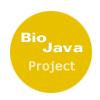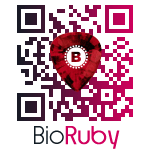| Please visit our ***NEW*** OBF/BOSC website: https://www.open-bio.org/ |
-
Google Summer of Code 2014 Ideas
The details of each of our project ideas are listed below, including potential mentors. Interested mentors and students should subscribe to the OBF/GSoC mailing list and announce their interest.
See the main OBF Google Summer of Code page for more information about the GSoC program and additional ways to get in touch with us.
Cross-project ideas
BioInterchange: Convert and Exchange Biological File Formants using RESTful web service
- Rationale
- BioInterchange Interchange data using the Resource Description Framework (RDF) and let BioInterchange automagically create RDF triples from your TSV, XML, GFF3, GVF, Newick and other files common in Bioinformatics. BioInterchange helps you transform your data sets into linked data for sharing and data integration via command line, web-service, or API. BioInterchange was conceived and designed during NBDC/DBCLS's BioHackathon 2012. Architecture and RDF serialization implementations were provided by Joachim Baran, Geraint Duck provided JSON and XML deserialization implementations and contributed to architecture decisions, guidance on ontology use and applications were given by Kevin B. Cohen and Michel Dumontier, where Michel brought forward and extended the Semanticscience Integrated Ontology (SIO). Jin-Dong Kim helped to define ontology relationships for RDFizing DBCLS' PubAnnotation category annotations. The main idea is to have a central service with can be used as a validator and as interchange service for different languages.
- Approach
- The project will identify the most common and used file formants for all the currently used language under OBF and will design a RESTful API and will project an implementation for all the supported languages. BioInterchange was developed with Ruby but the scope of the project is to have an agnostic system which let use implement a converter using the best language for that functionality. It expected to have a high traffic for the service so an appropriate refactoring or reimplementation using parallel techniques or languages devoted to parallel programming would be possible.
- Difficulty and needed skills
- The project is mid / high difficulty, aimed at talented students. Previous knowledge of Ruby or other scripting language is preferred and flexibility in learning other languages is requireed.
- The project requires
- Knowledge of advanced programming languages and meta-programming and some concept in parallelizing and web services design.
- Mentors
- Raoul J.P. Bonnal, Francesco Strozzi, Toshiaki Katayama, Joachim Baran
Language APIs for the Systems Biology Markup Language (SBML) through the JVM
- Rationale
- The standard Java implementation of SBML, JSBML, is used as a parser for various Java-based systems biology applications. This fulfills one niche, but the versatility of the JVM can be utilized to employ JSBML as a parser for systems biology applications that are written in other languages. Also, JSBML undergoes an active community effort to be up-to-date with current SBML standards.
- Approach
- This project will aim to present language APIs for languages that may want to employ the SBML structure without building a parser from scratch. Matlab, Mathematica, and Python APIs will be the focus for this project.
- Languages and skill
- Java, optional: Matlab, Python, (other language)
- Mentors
- Andreas Dräger, Alex Thomas
BioPerl
- BioPerl GSoC Page - project ideas and mentors
- Project website
- Information for new developers
- source code browser for bioperl-live (the main BioPerl code base), and all BioPerl sub-projects
- Priority list of things that need work, as another source for student-conceived project ideas
- Mailing lists
- IRC:
#bioperlon Freenode
NGS-friendly BioPerl code
- Rationale
- BioPerl is known to be slow re: any data sets, but particularly when dealing with very large data (e.g. anything related to NGS analysis. Can we make it better? Where should we focus our efforts?
- Approach
- Under the supervision of their mentor(s), the GSoC student will:
- Benchmark bottlenecks that lead to loss in performance for NGS analyses
- Refactor old classes or develop new optimized code for NGS analysis
- Challenges
- This can be a self-contained project, but will require a lot of discussion on what areas to focus on.
- Difficulty and needed skills
- easy to hard, depending on student's familiarity with the tools to be used. Student will need:
- excellent Perl programming skills, including familiarity with NGS datasets
- knowledge of modern Perl practices.
- Mentors
- Chris Fields, others?
Convert BioPerl-DB to use DBIx::Class
- Rationale
- Bioperl-db (the BioPerl bindings to BioSQL) in essence constitute a self-made ORM, invented at a time when DBIx::Class didn't exist yet. As such, it has some advantages (if you are willing to count overly clever features to be counted in this category), but arguably many more disadvantages, chief among them being the unsustainably small (you could also say non-existent) developer community supporting it, and the fact that DBIx::Class now has existed for years, and is fairly mature. So, rewriting Bioperl-db with a DBIx::Class (or another well-supported generic ORM) would stand to make a considerable impact on our ability to further develop Bioperl's relational storage capabilities, as well as BioSQL itself.
- Approach
- Under the supervision of their mentor(s), the GSoC student will:
- Start working on conversion of BioPerl-DB classes to using DBIx::Class
- write additional tests and improve documentation as needed
- Challenges
- BioPerl-DB is self-contained; this may require looking at the BioSQL schema and determining whether there are specific areas that need the most focus.
- Difficulty and needed skills
- easy to hard, depending on student's familiarity with the tools to be used. Student will need:
- excellent Perl programming skills, including familiarity with:
- DBIx::Class
- excellent Perl programming skills, including familiarity with:
- Mentors
- Hilmar Lapp, others?
Major BioPerl Reorganization (Part II)
- Rationale
- The initial run at this project had some success, but more work needs to be done. The final goal of this project is to find and break out as many well-defined subsections of BioPerl as possible, releasing them to CPAN along the way.
- Approach
- Under the supervision of their mentor(s), the GSoC student will:
- break current thousand-module monolithic distributions into smaller, more manageable pieces
- improve characterization of dependencies
- improve build and testing systems for new distributions
- write additional tests and improve documentation as needed for the reorganization
- Challenges
- BioPerl contains nearly 2000 modules, with very complex relationships between them.
- Difficulty and needed skills
- easy to hard, depending on student's familiarity with the tools to be used. Student will need:
- excellent Perl programming skills, including familiarity with:
- testing (prove, TAP::Harness)
- module authoring (Module::Build,Dist::Zilla,PAUSE)
- good knowledge of command-line text-processing tools like ack, grep, and Perl one-liners.
- version control systems (BioPerl uses git).
- excellent Perl programming skills, including familiarity with:
- Mentors
- Chris Fields, others?
Perl Run Wrappers for External Programs in a Flash
- Rationale
- BioPerl has a long tradition of providing wrapper objects for running external programs and parsing their output, mainly through the distribution called bioperl-run. Wrappers make it relatively easy to process data in highly customizable pipelines with the benefits of BioPerl objects and I/O. They also help to standardize the interfaces to typically idiosyncratic open-source utilities, reducing the burden on the developer. With new bioinformatics tools being released almost daily, however, it can be difficult for the BioPerl regulars to maintain a stable of run wrappers for the latest and greatest tools. Even harder is making the wrapper interfaces themselves conform to a standard API that users can count on.
- Possible approaches
- Integrate Galaxy's tool configuration file format in a pluggable way for developing a generic wrapper application.
- Improve/tighten/extend the Bio::Tools::Run::WrapperBase and Bio::Tools::Run::WrapperBase::CommandExts system for very general run wrappers, making them work robustly with the new Bio::Tools::WrapperMaker module currently under development. The goal will be to get these modules ready for release into the trunk.
- Are there any shortcomings to current schemes, such as Galaxy's or EMBOSS's acd format, that could be addressed with a newer schema?
See HOWTO:Wrappers and the above module documentation for more details.
- Difficulty and needed skills
- Medium. The student should understand or be willing to work hard at understanding BioPerl object-oriented style. Some familiarity with XML and XML Schema will help in getting up to speed. An interest in playing with new open-source bioinformatics tools, especially those for managing next-generation sequence assembly, would also be valuable.
- Mentors
- Mark Jensen, Chris Fields
Lightweight BioPerl modules
- Rationale
- Many current BioPerl classes are implemented in a greedy or heavy way, where all information is pulled into memory as objects. For instance, the current Bio::Seq implementation is the primary bottleneck for sequence parsing speed and can take up a ton of memory, particularly with whole-genome information and next-generation sequencing information. Storing the data in memory in a simple data structure and generating the objects lazily could help with speed. Alternatively, storing the data in a persistent manner would also help with memory issues, with the obvious trade-off for speed but having the nice side-benefit of consistent and possibly persistent ways of handling data.
- Approach
- Implement a Bio::Seq/Bio::PrimarySeq class (or other commonly-used BioPerl classes) that can deal with very large datasets in a memory-efficient manner. Implement at least one corresponding parser that can either parse records lazily (akin to an XML pull parser) or create lightweight objects. These could be considered two projects but they are interrelated (lightweight objects could have many different backends, including lazy parsing), so development should proceed with this in mind.
- Difficulty and needed skills
- medium to hard. Student should have an excellent command of Perl and data structures, experience with persistent storage mechanisms (such as a SQL-based RDBMS, CouchDB, etc), and some familiarity with parsing methodologies.
- Prior art
- Jason Stajich has started a SQLite-based lightweight Bio::Tree::Tree implementation on a GitHub branch at the recent GMOD Evolutionary Biology Hackathon at NESCent in Fall 2010.
- Mentors
- Chris Fields, Jason Stajich
BioPerl 2.0 and beyond
- Rationale
- Design or reimplement BioPerl classes without API constraint, using Modern Perl tools or Perl 6.
- Approach
- Most BioPerl code is over 6 years old and doesn't take advantage of Modern Perl tools, such as new methods available in Perl 5.10 and 5.12, Moose/MooseX, DBIx::Class, Catalyst, and more. Furthermore, a viable Perl6 implementation, Rakudo, is currently available. This gives us an enormous opportunity to redesign fundamental aspects of BioPerl without the necessity for development hindered by a requirement for backwards compatibility.
Two projects, Biome (Moose-based BioPerl) and BioPerl6 (Perl 6 BioPerl) have already started but are in a very early stage. One could participate in:
- IO implementations for object iteration, or Perl6 grammars for common formats
- Redesign of common BioPerl classes
- etc.
This is an area ripe for new student project ideas. The more focused the better! Discussion is a must, either via IRC or email.
- Difficulty
- Project-dependent
- Mentors
- Chris Fields, Rob Buels
Bio::Assembly
- Rationale
- A followup to the 2010 project "Alignment Subsystem Refactoring": Continued refinement of AssemblyIO.
- Approach
- SAM or ACE files once imported should have similar handles and/or methods.
- Difficulty and needed skills
- Medium to hard. Excellent command of Perl, familiarity with sequence alignment and alignment tools.
- Mentors
- To be determined.
Semantic Web Support
- Rationale
- There are great development opportunities in information discovery for bioinformatics using semantic web, specially thinking in the implementation of SPARQL queries for a "discoverable bio-cloud".
- Approach
- Previous efforts can be adopted and extended, such as resulting code from BioHackathon 3 and the code provided by Expasy. Using the modules of the Semantic Web with Perl community, built around RDF::Trine low-level API. There are two main areas to explore:
- Parsers and converters from and to RDF, including IO modules for GenBank, EMBL, several XML specifications, et cetera.
- Storage and retrieval of information using SPARQL.
- Difficulty and needed skills
- Medium. Familiarity with SeqIO modules and Perl itself. The student should also be familiar with RDF format and the RDF triples concept for Semantic Web.
- Mentors
- To be determined. Kjetil Kjernsmo can help mentor students wishing to explore the RDF::Trine direction.
BioJava
- BioJava GSoC Page - project ideas and mentors
- BioJava modules as another source for student-conceived project ideas
- source code for biojava-live (the main BioJava code base) and all BioJava sub-projects
- Mailing lists
- No IRC channel at present
JVM support and improvements for the Systems Biology Markup Language
See Native and JVM-based support for the Systems Biology Markup Language (SMBL)
BioPython
- BioPython GSoC Page - project ideas and mentors
- Project website
- Information for contributors
- Mailing lists
- Source Code
- No IRC channel at present
Indexing & Lazy-loading Sequence Parsers
- Rationale
- Bio.SeqIO's indexing offers parsing on demand access to any sequence in a large file (or collection of files on disk) as a biopython:SeqRecord object. This works well when you have many small to medium sized sequences/genomes. However, this is not ideal for large genomes or chromosomes where only a sub-region may be needed. A lazy-loading parser would delay reading the record until requested. For example, if region record[3000:4000] is requested, then only those 1000 bases need to be loaded from disk into memory, plus any features in that region. This is how Biopython's biopython:BioSQL interface works. Tools like tabix and samtools have demonstrated efficient co-ordinate indexing which could be useful here.
- Aside from being used via an index for random access, lazy-loading parsers could be used when iterating over a file as well. This can potentially offer speed ups for tasks where only a fraction of the data is used. For example, if calculating the GC content of a collection of genomes from GenBank, using Bio.SeqIO.parse(...) would currently needlessly load and parse all the annotation and features. A lazy-parser would only parse the sequence information.
- Approach & Goals
- Useful features include:
- Internal indexing of multiple file formats, including FASTA and richly annotated sequence formats like GenBank/EMBL and GTF/GFF/GFF3.
- Full compatibility with existing SeqIO parsers which load everything into memory as a `SeqRecord` object.
- Difficulty and needed skills
- Hard. Familiarity with the Biopython's existing sequence parsing essential. Understanding of indexing large files will be vital.
- Possible Mentors
- Wibowo Arindrarto, Peter Cock, others welcome
BioRuby
- BioRuby GSoC Page - project ideas and mentors
- Project website
- developers mailing list
- source code
- IRC:
#biorubyon Freenode
An ultra-fast scalable RESTful API to query large numbers of genomic variations
- Rationale
- VCF files are the typical output of genome resequencing projects (http://www.1000genomes.org/node/101). They store the information on all the mutations and variations (SNPs and InDels) that are found by comparing the outputs of a NGS platform with a reference genome. These files are not incredibly large (a typical uncompressed VCF file is few gigabytes) but they are full with information on millions of positions in the genome where mutations are found. Large resequencing projects can produce hundreds or thousands of these files, one for each sample sequenced.
- Existing tools (such as VCFTools or BCFTools) offer a convenient way to access these files and extract or convert the information present, but are limited in functionalities and speed when more complex queries need to be performed on these data. With existing tools it is very complicated, if not impossibile, to retrive information when working on many VCF files and samples together to compare, for instance, the variations found in 100 samples and extract all the mutations that are present in 50 samples but are not present in the other 50 and so on.
- Approach
- The project should develop a RESTful API to address the issues described in the rationale and to allow users to manipulate and compare genomics variation information for hundreds of samples. A database engine will be required to store the information and to support the data mining. Unstructured database engines such as noSQL databases or key-values stores can all be valid alternatives to combine high-speed with data flexibility. The decision on the best database engine to be used will be discussed between the student and the mentors and within the OpenBio community. Given the high amount of information that will need to be processed by such an application, scalable and fast languages such as JVM-based languages like Scala or JRuby will be a good choice. The project should also take care of the deploy of such an API, by creating a Ruby gem or a JAR that users can install and use right away with their datasets.
- Difficulty and needed skills
- The project has an average difficulty and it is aimed at talented students who wants to develop a fast API to address these problems.
- The project requires
- Knowledge of advanced programming languages. Some experience and knowledge of databases and data mining will help managing the information of VCF files.
- Mentors
- Francesco Strozzi, Raoul J.P. Bonnal



